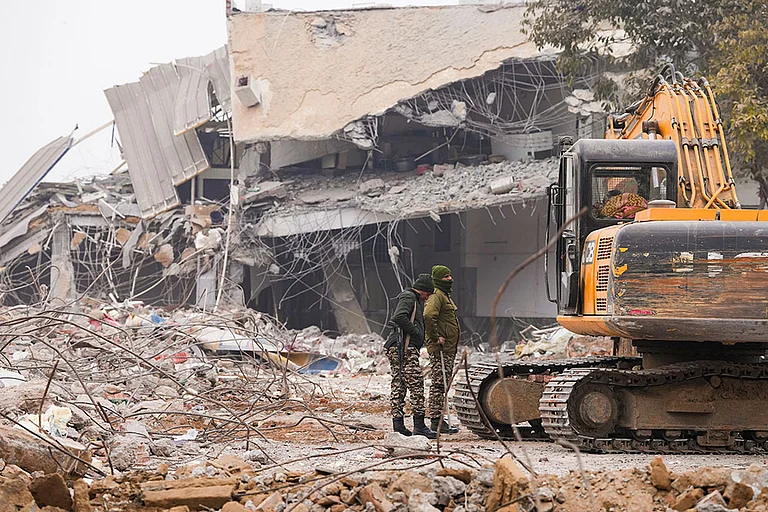The evidence of South Asia’s prominence among the global climate change hotspots is only getting stronger. It was Pakistan, northwest, and northern India in 2022 who had to bear the brunt of heat waves. In 2023, it’s eastern and northeastern India and Bangladesh.
Multiple Indian states in April, including West Bengal, Maharashtra, Odisha, Tripura, and Meghalaya, shut schools for days to save children from the heat wave, while states like Uttar Pradesh and Jharkhand rescheduled school timings. On June 8, the day the Indian Meteorological Department announced the setting in of the southwest monsoon over the southern state of Kerala, states from Goa in western India to Uttar Pradesh in the north and Jharkhand in the east extended summer holidays in schools.
Bangladesh, too, faced heat waves in April and June, resulting in frequent and prolonged power cuts and school closures.
Such trends of extended summer vacation or overall more holidays during the summer months in schools in India, Pakistan, and Bangladesh are likely to become the new norm, adding the education sector to the list of areas likely to suffer from direct impacts of climatic changes.
Only in April, World Meteorological Organisation (WMO) pointed out how heat waves hurt crop production in India and Pakistan last year. The same month, addressing a workshop on heatwaves organised by the non-government advocacy group Climate Trends in Bengaluru, climate scientist Luke Parsons said of the estimated 220 billion hours/year loss of productivity, India alone is supposed to lose approximately 101 billion hours/ year, equivalent to around 23 million jobs lost.
Global warming of 1.5°C from the pre-industrial level would leave 9 crore people in India exposed to its impacts, predicted a research paper published in the journal Nature in May. Currently, the world is 1.2°C warmer than pre-industrial level.
“Both India and Nigeria” – the two countries with the greatest population exposed – “already show ‘hotspots’ of increased exposure to extreme heat due predominantly to warming, consistent with our prediction that they are at greatest future risk,” said the paper, titled ‘Quantifying the Human Cost of Global Warming.’
India witnessed its hottest December in 122 years in 2022, with the highest mean temperature to the tune of 21.49°C, one degree above the normal temperature for the month. Then, the mercury in February 2023 created another landmark – the hottest February since 1901, the year when the Indian Meteorological Department (IMD) started collecting data. February also recorded 1,156 forest fire incidents across India between the 13th and the 20th of the month.
Whether the official summer months of March, April, May, and June in 2023 record overall higher-than-normal temperature remains to be seen. The rise of mercury in India during different months has been leading to the shattering of many records over the past few years – all five warmest years in India on record since 1901 were in the past fifteen years – 2016, 2009, 2017, 2010, and 2022. In fact, the IMD said that 11 out of the 15 warmest years were recorded between 2008 and 2022.
A 2021 research paper, titled Heat stroke-related deaths in India pointed out that there has been a statistically significant increase in heat-related deaths in India, from 3,863 cases in 2001-2005 to 6,411 cases in 2011-2015.
Last year was the fifth warmest year in India since nationwide recordkeeping started in 1901, the Indian Meteorological Department said earlier this year, the country’s annual mean land surface air temperature averaged having been +0.51C above the long-term average (1981-2010 period).
Such warnings are pouring in for quite a few years now. A McKinsey Global Institute report published in November 2020, titled 'Will India be Too Hot to Work?' said that by 2050, India could become “one of the first places in the world to experience heat waves that cross the survivability limit for a healthy human being sitting in the shade.” It is estimated that the effective number of outdoor working hours lost will increase by approximately 15 percent by 2030.
Adaptation and capacity building
Repeated scientific warnings have made it evident that such occurrences of heat waves cannot be treated as usual weather patterns – rather, they are part of the new normal, requiring long-term policy interventions at the government level.
Heatwaves of the future are likely to be “more widespread in area and of longer durations in India,” said a report published in May, titled ‘Climate Science to Inform Adaptation Policy: Heat Waves Over India in the 1.5°C and 2°C Warmer Worlds.’ It said that there is an increased probability of heat waves during June and July when the Indian monsoon is in full swing and humidity is high. This makes the heat events of even greater health risk.
“While the highest temperatures in heat waves may not increase much in future climates, the duration and areal extent of the heat waves will most likely increase, leading to the emergence of new heat wave-prone zones in India,” it said.
The results of their investigations indicate that the joint frequencies of the longest duration and large area events could be nearly threefold greater when the world becomes 1.5 °C warmer than the pre-industrial level. In the case of 2.0 °C warming from the pre-industrial level, the joint frequencies can be fivefold greater.
Like most other climatic events, this too would impact the marginalized populations the most – in this case, it would be the people who must go outside to earn a daily wage, such as street vendors, construction and farm workers, and traffic police, who consequently lack access to consistent electricity and cooling at home, limiting their options to cope with prolonged heat stress, a May 2022 report by The World Weather Attribution pointed out.
A May 2023 report by the same organisation, titled ‘Extreme humid heat in South and Southeast Asia in April 2023…’, listed a range of solutions, including self-protective action, early warning systems for heat, passive and active cooling, urban planning, and devising Heat Action Plans (HAP), and pointed out that heat-related fatalities decreased in Gujarat’s Ahmedabad and parts of Odisha where heat action plans have been in place.
“However, these solutions are often out of reach for the most vulnerable people, highlighting the need to improve vulnerability assessments and design interventions that account for group-specific needs,” the report said. It said that a lack of vulnerability assessment frameworks limits current Heat Action Plans from truly addressing the needs of those who are most vulnerable, and improvement in this area can help to make current plans more effective.
Parsons suggested adaptation measures like shifting heavy-labour work to the early morning hours, acclimatisation, scope for workers to take breaks under shades, and their accessibility to clean and cool drinking water, among others.
While the National Disaster Management Authority (NDMA) issued guidelines in 2019 for states to prepare their HAPs, a March 2023 paper, titled ‘Heat Action Plans With Insights for Transformative Climate Action’, pointed out that of the 37 HAPs developed at state, district, and city level that they reviewed, nearly all have an oversimplified view of heatwaves, are underfunded, have weak legal foundations and insufficient transparency and many do a poor job at identifying and targeting vulnerable groups.
“While most HAPs identify broad categories of vulnerable groups, the list of solutions they propose do not necessarily focus on these groups,” it said.
India, clearly, has a long way to go to protect its people from such ‘new normals.’


























